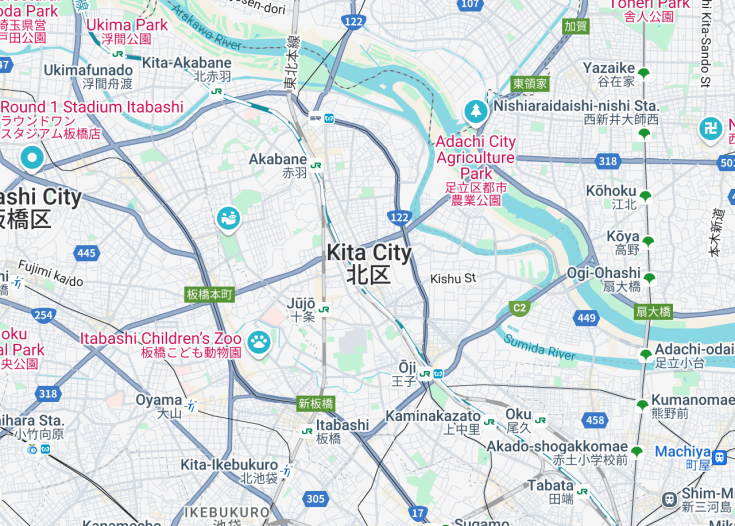Kita Ward, based in the northern part of Tokyo, Japan, offers a blend of cultural history and modern conveniences, making it an appealing destination for travelers. It is known for its vibrant natural parks, historic shrines, and bustling shopping districts. Among its notable attractions are the Asukayama Park, famous for its cherry blossoms, and the ancient Oji Shrine. The ward also boasts the Paper Museum, a unique establishment dedicated to the history of paper, reflecting Kita’s historical significance in Japan’s paper industry.
To make the most of your visit to Kita Ward, consider exploring its lesser-known backstreets and local cafes where traditional Tokyo culture comes to life.
Plan your visit during the cherry blossom season in early spring to experience Kita Ward’s parks in their full glory, offering an unforgettable sightseeing experience.
Kita Ward: A Vibrant District in Tokyo
| Country | Japan |
| Time in Kita Ward | GMT+9 |
| Language spoken | Japanese |
| Population | 350,914 (As of 2020, sourced from Tokyo Metropolitan Government) |
| Currency | Japanese Yen (¥, JPY) |
| Airports |
|
Kita Ward, located in the northern part of Tokyo, Japan, is a compelling blend of tradition and modernity. Known for its residential tranquility and commercial vibrancy, it is distinguished by cultural heritage spots like the Asukayama Park, which has been popular since the Edo period. Kita Ward is also home to a wide array of shops, traditional eateries, and sprawling green spaces which contrast with its urban settings.
Historically, Kita has been a significant location since the Edo period when it served as an essential area for transportation and trade along the Sumida River. Today, Kita Ward is renowned for its educational institutions and cultural facilities, including libraries and museums that attract researchers and history enthusiasts alike. The district’s community is active and boasts a strong sense of local identity and community participation.
The area’s economic scene is buoyed by a mix of local businesses and larger conglomerates, providing robust employment opportunities to its residents. Moreover, Kita Ward’s proximity to central Tokyo makes it a desirable location for both long-term residents and newcomers.
Where is Kita Ward?
Kita Ward is one of the 23 special wards in Tokyo, Japan, located towards the city’s northern end.
Distances:
| Route | Distance by car | Time by car |
|---|---|---|
| Tokyo to Kita Ward | 10.6 mi / 17.1 km | 40 min |
| Yokohama to Kita Ward | 28 mi / 45 km | 50 min |
| Chiba to Kita Ward | 34 mi / 55 km | 65 min |
What is Kita Ward famous for?
Notably famous for its lush Asukayama Park which dates back to the Edo period, Kita Ward attracts visitors keen on experiencing parts of Japan’s rich cultural history amidst natural beauty.
History
Pre-20th Century
The area now known as Kita Ward, located in the northern part of Tokyo, Japan, has a rich history that dates back several centuries. Initially, it was composed of small rural villages engaged in agriculture and fishing. The Edo period (1603-1868) brought significant changes with the construction of irrigation canals which improved farming in the region, leading to slight economic growth.
20th Century Development
Kita Ward’s modern development began in earnest in the early 20th century. The area witnessed substantial urbanization as Tokyo expanded. The Great Kanto Earthquake of 1923 and the subsequent rebuilding efforts accelerated Kita Ward’s transformation from a predominantly agricultural area to a more urbanized one. Post-World War II, during Japan’s economic boom, Kita Ward developed rapidly with the construction of residential complexes and the improvement of infrastructure.
Contemporary Kita Ward
In recent decades, Kita Ward has evolved into a vibrant municipality with a mix of residential, commercial, and industrial spaces. It’s known for its excellent educational institutions, cultural sites, and parks, which contribute to its unique identity within Tokyo. Present-day Kita Ward is a notable example of successful urban planning and community development in Japan.
Visit Kita Ward
What to see and do in Kita Ward, Japan
Exploring Kita Ward offers a blend of historical and contemporary attractions. Exceptional sights include the Asukayama Park which is perfect for cherry blossom viewing in spring, and the ancient Oji Shrine that echoes the area’s spiritual heritage. For those interested in local culture:
- Visit the Paper Museum to learn about the history of papermaking.
- Explore the Kyu-Furukawa Gardens which combines Western and Japanese garden designs.
Additionally, a stroll along the Sumida River provides a serene escape from urban life with picturesque views and occasional riverside events.
Local Festivals and Events
Kita Ward is home to a variety of cultural events that reflect its rich heritage. Notably, the Kita Fireworks Festival in summer and the Oji Inari Shrine Festival in January are highlights. Both festivals attract visitors and locals alike for their vibrant displays and traditional performances, encapsulating the spirit of the community.
Best time to visit Kita Ward
The ideal times to visit Kita Ward are during the cherry blossom season in early April or in autumn when the foliage transforms the landscapes into vibrant hues of red and gold. Both periods offer mild weather and the natural beauty of Kita Ward is at its peak, providing splendid opportunities for photography and leisurely walks.
is Kita Ward worth visiting?
Indeed, Kita Ward is worth visiting for its distinct blend of natural beauty, historical sites, and modern attractions. The area offers a quieter, more laid-back experience compared to the bustling centers of Tokyo, making it an excellent getaway for those looking to experience a different side of city life. The cultural events and beautiful parks provide deep insight into Japan’s traditions and contemporary lifestyle, appealing to both history buffs and casual tourists alike.









